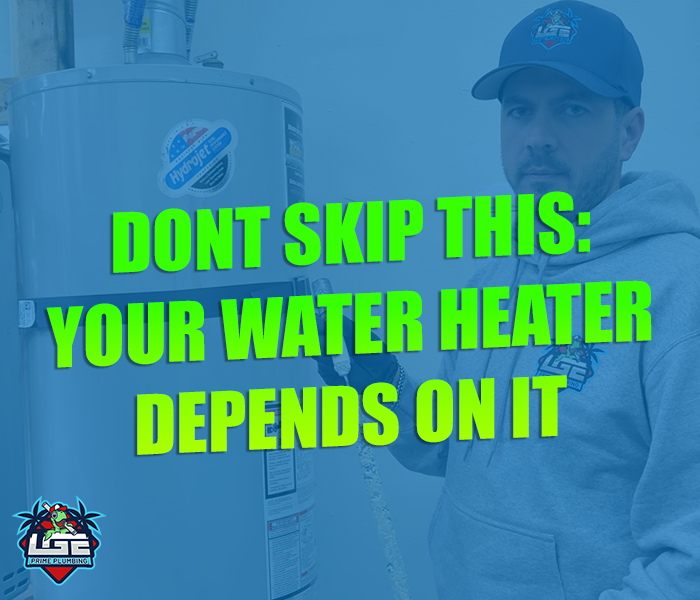If you want your water heater to last, there’s one small part you can’t afford to overlook: the anode rod. This unsung hero inside your tank works behind the scenes to prevent rust and corrosion. In this post, we’ll explain what an anode rod does, why it’s so important, how to tell if it needs replacing, and how regular checks can save you thousands by avoiding early water heater failure.
If you own a water heater, there’s one small but crucial part you probably never think about: the anode rod.
This hidden component plays a huge role in protecting your water heater. It prevents rust and corrosion inside the tank, which keeps your system running longer and saves you money on costly replacements.
Most homeowners never check their anode rod. That’s a mistake that can lead to leaks, total tank failure, and an expensive new water heater long before you should need one.
At LGE Prime Plumbing, we help homeowners and business owners throughout Chula Vista, Bonita, and the surrounding San Diego area take care of their water heaters. That means fewer surprises and a system that lasts for years.

Inside your tank-style water heater is a long metal rod, usually made of magnesium, aluminum, or zinc. It’s called a “sacrificial anode rod.”
This rod attracts the corrosive elements in your water. Instead of attacking the walls of your water heater tank, these corrosive minerals go after the rod. Over time, the rod breaks down, sparing the tank from rust.
Without an anode rod doing its job, your tank would start to corrode from the inside out. That means:
• Rusty, discolored hot water
• Leaks that can damage your home
• Needing a full water heater replacement years sooner
Anode rods typically last anywhere from 2 to 5 years. That depends on a few factors, including:
Water quality: Hard water speeds up corrosion.
How much hot water you use: More usage wears the rod faster.
The material of your tank: Some higher-end tanks come with better protection.
Maintenance habits: Regular inspections and flushing extend the life of the rod and the heater.
👉 Pro Tip: If your water heater is over 3 years old and you’ve never had the anode rod checked, it’s time. Waiting could lead to hidden corrosion.
Most people don’t think about the anode rod until they see clear warning signs. Watch for these clues:
• A metallic or rotten egg smell in your hot water
• Rusty or brown water coming from your faucets
• Popping or rumbling noises from the water heater (caused by sediment reacting to corrosion)
• Hot water runs out faster than it used to
• A water heater that’s over 5 years old with no maintenance record
Ignoring these signs could mean corrosion is already eating away at your tank. That’s how small problems turn into full system replacements.
At LGE Prime Plumbing, we don’t just fix problems — we help prevent them.
When we perform a water heater maintenance service, we include:
✅ Anode rod inspections and replacements to stop corrosion before it starts
✅ Water heater flushing to clear out sediment that can damage your tank and lower efficiency
✅ Leak detection to catch small issues early
✅ Safety checks on temperature, pressure, gas lines, and venting to keep your family protected
We’ve spent over a decade building a reputation for honest, reliable plumbing across Chula Vista, Bonita, and all of San Diego. Our licensed plumbers show up on time, respect your home, and give you transparent pricing without hidden fees.
A quick anode rod inspection is one of the best small investments you can make. It can extend the life of your water heater by years, saving you hundreds — or even thousands — of dollars.
Instead of waking up to a flooded garage or no hot water, you can relax knowing your water heater is protected and working efficiently.
If your water heater is over 3 years old and you’ve never had the anode rod checked, don’t wait. A quick inspection now could add years to your system’s life and help avoid surprise breakdowns.
We offer:
• Fast, same-day and next-day appointments
• Friendly, licensed plumbers who respect your time and home
• Complete water heater maintenance, including anode rods, flushing, and safety checks
• Warranties on our work, so you have peace of mind
Our Team Is Here For You!
Some homeowners try to do it themselves. But checking or replacing an anode rod involves:
• Turning off your water and power (or gas)
• Draining part of your tank
• Using specialized tools to unscrew and remove the rod
• Making sure everything seals correctly afterward
If done wrong, it could lead to leaks, pressure issues, or even void your manufacturer warranty.
That’s why it’s best to trust a licensed plumber. A professional can safely inspect and replace the anode rod, spot other potential problems, and make sure your system stays under warranty.
FAQs About